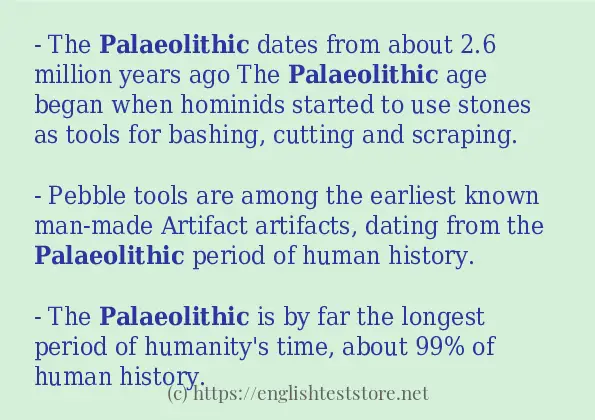How to use in-sentence of “palaeolithic”:
– The Palaeolithic dates from about 2.6 million years ago The Palaeolithic age began when hominids started to use stones as tools for bashing, cutting and scraping.
– Pebble tools are among the earliest known man-made Artifact artifacts, dating from the Palaeolithic period of human history.
– The Palaeolithic is by far the longest period of humanity’s time, about 99% of human history.
– The other key paleolithic sites in the UK are Happisburgh, Pakefield, Bontnewydd Palaeolithic sitePontnewydd, Paviland, and Gough’s Cave.
– The Palaeolithic from Greek: παλαιός, “palaios”, “old”; and λίθος, “lithos”, “stone” lit.
– He invented the terms Palaeolithic and Neolithic to denote the Old and New Stone Ages respectively, but more notable was his introduction of a Darwinian view of human nature.
– For most part of the lower Palaeolithic stage, humans lived close to river valleys with sparse forest cover or in grassland environments.

Example sentences of “palaeolithic”:
- The prehistoric period during which the Palaeolithic civilisations existed in the Tamil Nadu region has been estimated to span the period from about 50,000 BCE until around 3000 BCE.
- These areas already had rich ecological variation that was being exploited by hunter-gatherers in the Upper Palaeolithic and Mesolithic periods.
- During the Palaeolithic Age humans grouped together in small bands.
– The prehistoric period during which the Palaeolithic civilisations existed in the Tamil Nadu region has been estimated to span the period from about 50,000 BCE until around 3000 BCE.
– These areas already had rich ecological variation that was being exploited by hunter-gatherers in the Upper Palaeolithic and Mesolithic periods.
– During the Palaeolithic Age humans grouped together in small bands.
– The population density was very low and so far only two localities of this lower Palaeolithic culture have been found in south India.
– It is a female figurine known as the Venus of Dolní Věstonice, from a palaeolithic site in Moravia, Czech Republic.
– The geological period which corresponds to the Palaeolithic is the Pleistocene.
– After the Palaeolithic follows the Mesolithic and Neolithic eras, which marks the end of Stone Age.
– The Ainu have strong similarities with Palaeolithic Europeans and people of the Middle East as well as with Native AmericanNative American groups of the northwestern coastal culture area in North America.
– People from the Palaeolithic era drew well.
– Hand axes from the Palaeolithic period were found there, and gave this name to the respective period.
– Acheulean is the industry of stone tool manufacture by Homoearly humans of the Lower Palaeolithic era in Africa and much of West Asia and Europe.
– Movius noticed that the palaeolithic stone tools from sites east of northern India never contained handaxes.
– A Middle Palaeolithic origin of music? Using cave-bear bone accumulations to assess the Divje Babe I bone ‘flute’.
– Prehistory: from the palaeolithic to the Badarian culture.
– There are at least 100 types of tools in the Upper Palaeolithic compared to a maximum of 30 tools in the Mousterian.
– They were seasonally occupied by nomadic groups of people during the Upper Palaeolithic and Mesolithic periods.
